The Sarah’s Walking Club Wildlife Scavenger Hunt kicks off February 1 and runs through March 15. Sarah partnered with Hillsborough County’s Rebecca Winch to come up with the list.
Here’s how it works:
- Use the photos, videos and clues below to find at least 10 of the animals on this list at parks and preserves around the Tampa Bay area.
- A new animal will be added to the list every Friday. Find out what it is by watching Good Morning Tampa Bay between 6 a.m. and 7 a.m. on February 4, 11, 18, 25 and March 4.
- Post photos of what you see in the Sarah’s Walking Club Facebook group.
- When you find at least 10 of the animals, fill out this form to be entered into a contest to win a Sarah’s Walking Club item of your choice from ABCActionNews.com/shop.
Happy hunting!
If you have trouble downloading, click this link.
1. White-tailed deer

Rebecca says: These fleet creatures can be found all over Florida. In the winter, you’ll see antlers peeking out over palmetto and tall grass as the bucks graze. Look for the flash of a white tail as a startled herd of deer bolts away from the trail – and if you want the best chance of spotting these wary animals, make sure to hike quietly!
2. Pileated woodpecker
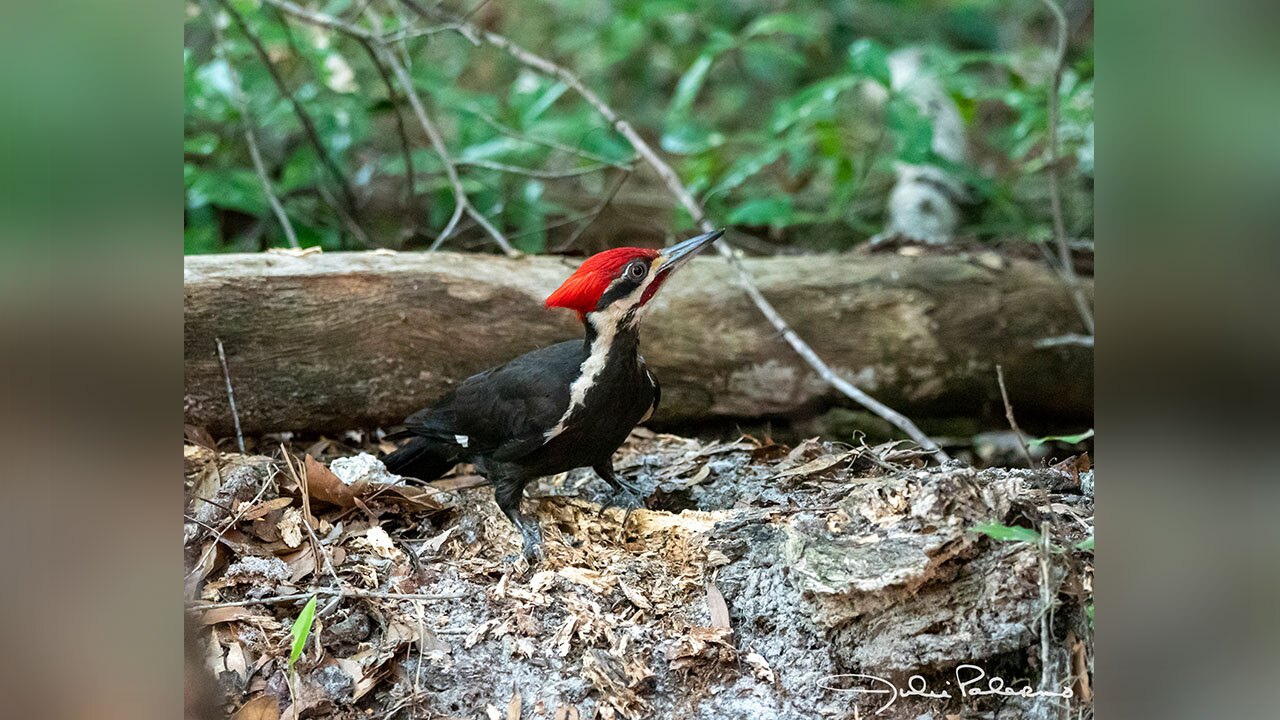
Rebecca says: These large black, white, and red woodpeckers can make quite a racket! Using their tough beaks, they loudly drill into tree bark to find tasty grubs. You’ll spot them perched on tree limbs and peering out of small holes in snags, or standing dead trees. You may also see them winging through the woods with their distinctive, dipping flight pattern, or hear them drumming up dinner on a nearby tree trunk. Woodpeckers also drum in distinctive patterns to communicate with other individuals and claim territory.
3. Great blue heron

Rebecca says: Majestic both in flight and on the ground, these large wading birds have smoky blue-grey feathers and a distinctive white and black face marking. They stalk the shallows to hunt, dipping their long slender necks and spearing prey with their impressive beaks. Great blue herons are often found in coastal areas but can live far inland too. They often nest in colonies, building multiple large solid nests in trees near water sources.
4. Feral hog

Rebecca says: Brought to Florida by Spanish colonizers in the 1500s, these invasive ungulates have now spread over most of the continental US. They reproduce quickly, with sows bearing multiple litters of piglets a year, and can tear up acres of ground in a single day while rooting for tubers, grubs, and acorns. Feral hogs harm native species through predation and competition and land managers around the country use various strategies to control hog populations.
5. Cuban treefrog

Rebecca says: This invasive amphibian species is native, as the name suggests, to Cuba and several other islands. Cuban treefrogs are predators of other amphibians as well as some reptiles and have caused serious harm to Florida’s native frog population. These sticky little climbing frogs secrete a mucus that burns if it gets in your eyes, so watch out! They’re often found in dark places, like mailboxes and tree cavities, and they’ll jump in any direction when startled (including towards your face).
6. Fiddler crab

Rebecca says: These scuttling arthropods are a fun sight along coastal mud flats and in mangrove swamps. The male crabs’ unevenly balanced claws may look comical, but females do chose the males with the largest claws to mate with! Fiddler crabs live in large colonies along the Tampa Bay and other water bodies, burrowing and sifting through the sand for particles of algae and plant matter to eat. Look for them rushing across your path on sandy coastal trails or climbing through mangrove roots in tidal areas.
7. Gopher tortoise
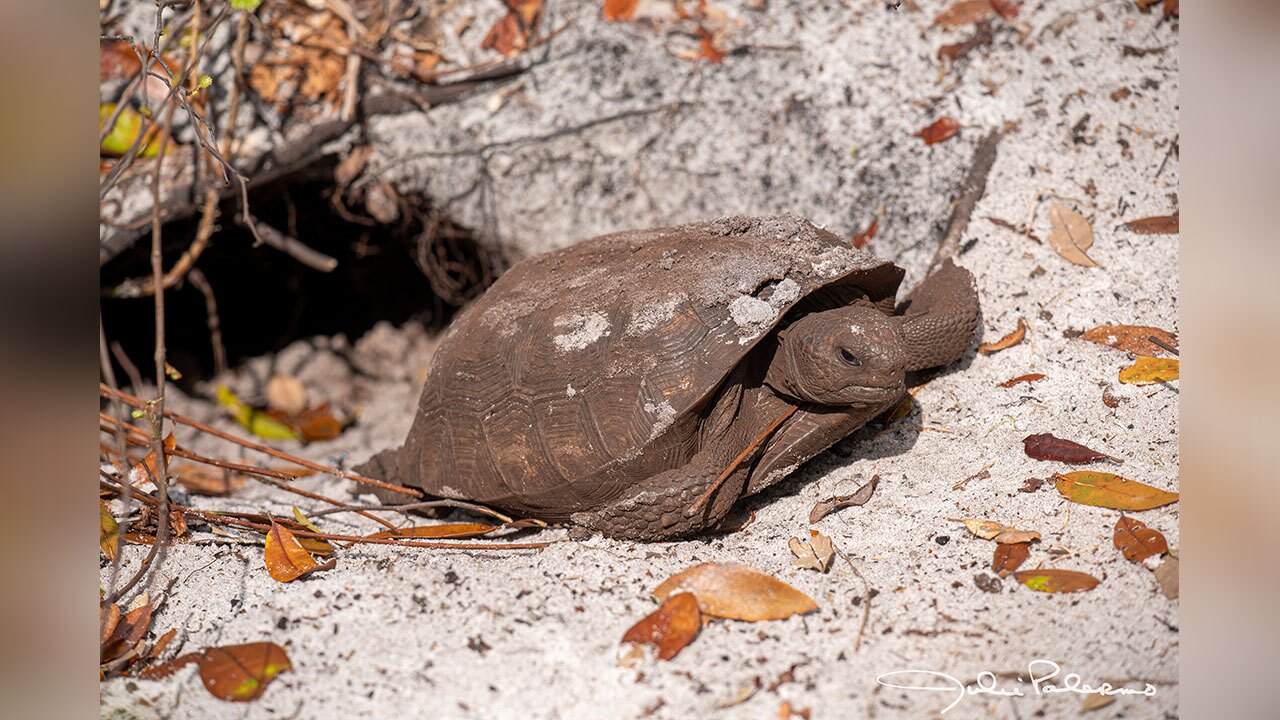
Rebecca says: Because they’re a common sight along hiking trails in dry, grassy areas, many people are surprised to learn that gopher tortoises are actually listed as threatened in Florida. Rapid development of natural areas over the past century has destroyed much of the habitat that these slow-moving reptiles depend on. Gopher tortoises dig cool, shady burrows to live in, and over 300 other species of animals use these burrows for shelter too! Look for a large patch of sand with a burrow entrance shaped like a capital D.
8. Southern black racer

Rebecca says: The black racer is one of the most commonly seen snakes in Florida, and it definitely lives up to its name – unless you’re especially observant, all you’ll probably see of this slender speedy snake is the tip of its tail as it slithers away! Black racers are often seen in backyards and neighborhood parks, and these non-venomous snakes eat lots of the rodents that we try to keep out of our houses. Look for them sunning themselves in open areas or even laying across the trail in the winter!
9. Barred owl

Rebecca says: With “barred” or striped wings and a deep hooting call, the barred owl can be found in swampy areas and riverbank habitat all over Florida. Listed for the distinctive “who-cooks-for-you, who-cooks-for-you-two” sound as pairs call back and forth to each other in from afternoon to evening. Look for these large owls in thickly wooded areas gliding silently between the trees – and remember, hearing the call counts for scavenger hunt purposes, as they’re much easier to hear than to see!
*Hearing call counts as a sighting
10. American Osprey

Rebecca says: That’s not a bald eagle! Ospreys do share some characteristics with their larger cousins, such as a white head and a love for fish. However, ospreys are smaller and have a white stomach, striped tail, and M-shaped wings in flight, while bald eagles have a brown stomach, a white tail, and straighter wings. Osprey are also known as fish hawks and can often be seen scooping up fish from rivers, lakes, and estuaries. They build huge nests out of sticks in trees, platforms, and power poles – look for osprey nests near any body of water!
11. Reddish Egret

Rebecca says: Once common, these beautiful wading birds were decimated by the feather trade over the last two centuries and are listed as a threatened species in Florida. With smoky-grey plumage and a crested red-brown head, the reddish egret stalks the shallows searching for food, often raising its wings to create a shadow on the water’s surface and attract schools of small fish. These rare egrets can be found in coastal areas, feeding in salt marshes and protected estuaries. They use their powerful, two-toned bill to catch fish and are usually very active feeders, running through the water to find and capture prey.
12. Southern fox squirrel

Rebecca says: It’s a fox! It’s a squirrel! It’s a fox squirrel! If you’ve ever seen a huge squirrel with a tail so fluffy that you truly thought it might be a fox, congratulations - you’ve spotted the elusive Southern fox squirrel. These large squirrels live in open pine flatwoods habitat, where they spend much of their lives foraging for food on the ground. They’re experts at “disappearing,” quickly running up trees when disturbed and then circling the trunk to hide from whatever animal (or person) has disturbed them. If you want to see a fox squirrel, make sure to hike quietly as they’re easily startled.
13. Bobcat
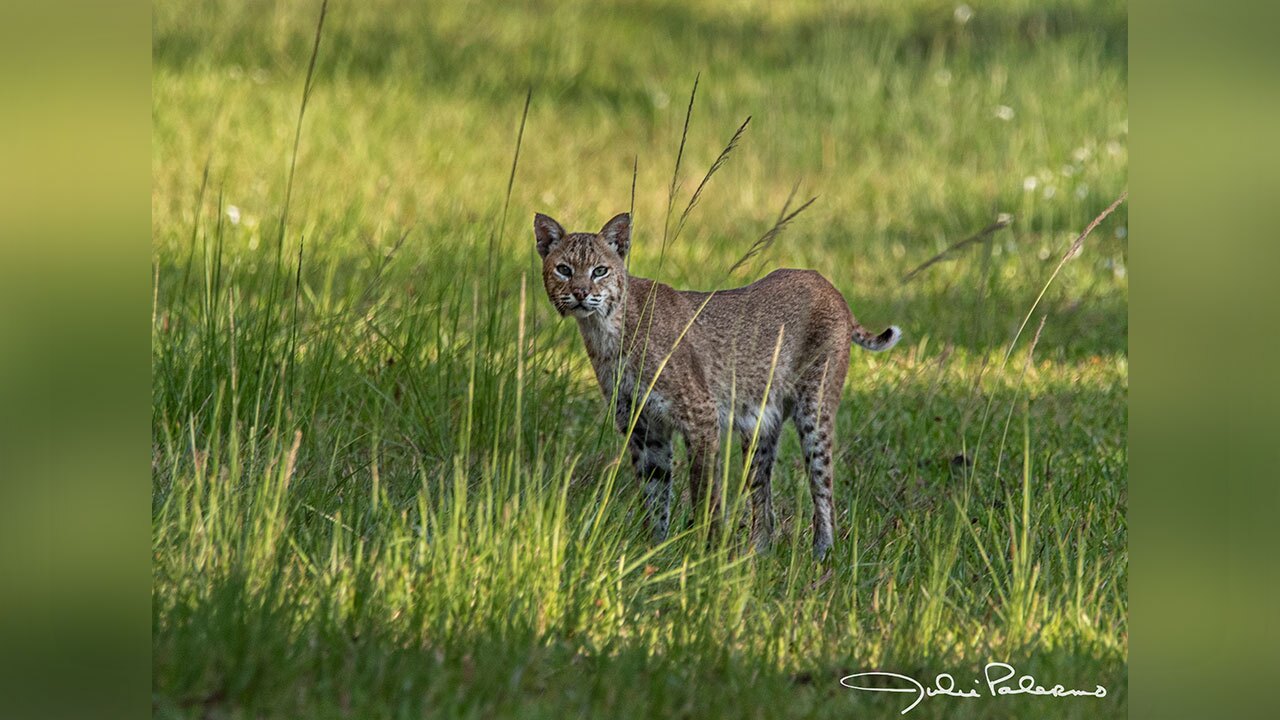
Rebecca says: Although they’re actually abundant in Florida, bobcats are elusive and rarely seen. They move quickly and quietly and can fade into the brush as soon as they hear people. Bobcats are often mistaken at a distance for their much rarer cousin, the Florida panther, which is much larger and has an extremely long tail with a characteristic J-shaped curve at the end. Bobcats have tan fur with some white and darker brown markings, and often have distinctive white spectacles and other white facial markings. Contrary to popular belief, bobcats can have tails up to 18 inches long. These native felines can be found in areas with dense underbrush like thick scrub, oak hammocks, and swamps.
14. River otter

Rebecca says: Despite their playful reputation, these large semi-aquatic mammals can be territorial, so make sure to keep your distance! River otters are found throughout much of the United States and Canada. They live in social groups, hunting in the water and on land for food and denning in holes dug by other animals as well as in hollow logs and other natural cavities. These opportunistic predators will eat almost anything – fish, crustaceans, birds, amphibians, small mammals and aquatic insects are all fair game. River otters can also be found in saltwater and coastal areas.
15. Belted Kingfisher

Rebecca says: Tiny but mighty, these small crested fishing birds have long, solid beaks, gray-blue back and breast bands, and a white throat and belly. Females also have a reddish-brown belly band. Easily recognizable by their fluffy grey crested heads, belted kingfishers can generally be found near permanent water bodies like retention ponds, perching on vegetation overhanging the water. They’re well-named, fishing for food by diving up to two feet under the surface. Belted kingfishers can be found throughout the country and usually nest in small underground burrows dug by the breeding pair each year.
Mystery animal #1: American Alligator

Rebecca says: One of Florida’s most famous native species, the American alligator is the largest reptile native to North America. Although they may be intimidating, alligators generally don’t want to be close to people – and we can help keep it that way by never feeding alligators or leaving food, including fishing scraps, where they can find it! These giant reptiles can be found in just about every body of water in Florida. Female alligators are excellent parents and will defend their young, so steer clear of baby alligators – their mom is probably close by!
*Find an alligator between February 4th and March 15th for it to count in the scavenger hunt
Mystery animal #2: Florida manatee, Trichechus manatus latirostris
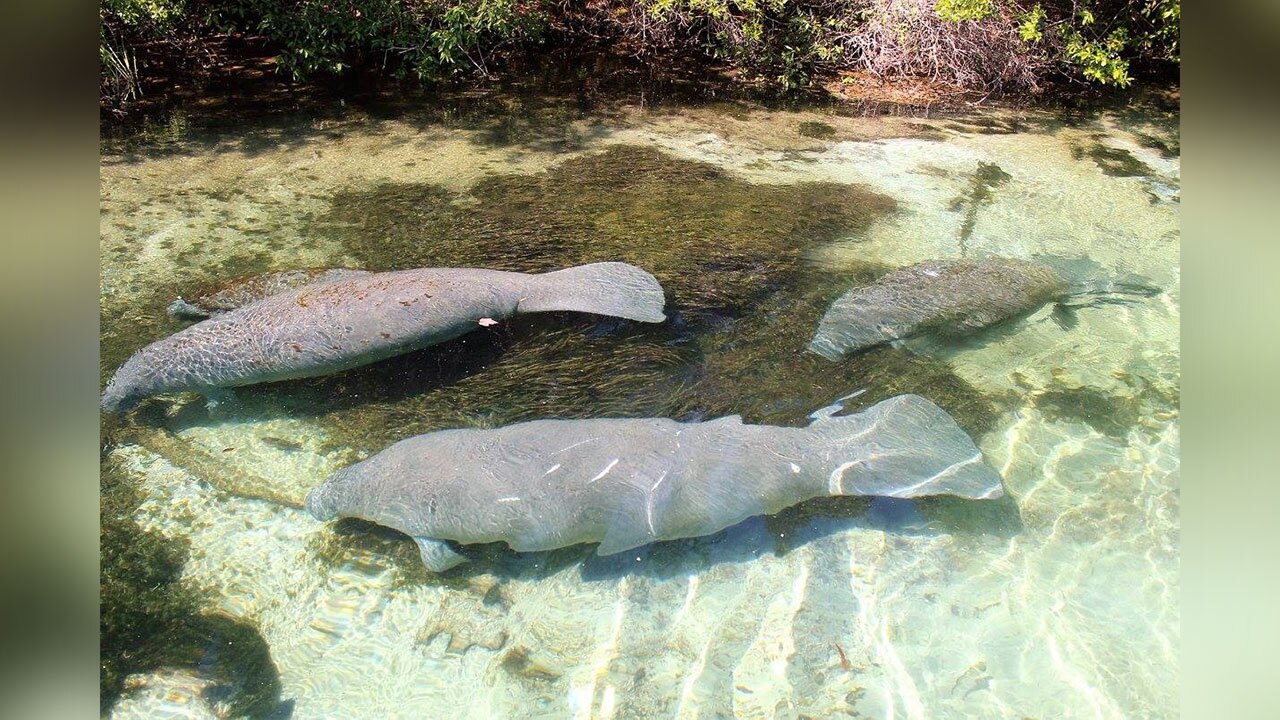
Rebecca says: These gentle giants can always be found off the coast of Florida, but they come even closer in the winter. Between November and March, water temperatures in the Tampa Bay and the Gulf of Mexico can drop below 60 degrees- a little too chilly for our tropical friends. During these colder months, manatees move in towards the coastline and swim up rivers in search of warmer water near springs and power plants. Manatees are currently listed as threatened, but efforts are underway to get them added back onto the endangered species list.
Mystery animal #3: Florida sandhill crane

Rebecca says: These tall and elegant birds are a Florida favorite and can stand almost 4 feet tall with a wingspan over 6 feet! They’re easily recognized, with long necks and legs coupled with a patch of bright red skin which extends down like a mask over the face, and can generally be found in open grassy areas. Sandhill cranes are often seen in pairs and are monogamous, raising one or two young together each year. In late fall and early winter, huge flocks of a northern subspecies called the greater sandhill crane (Grus canadensis tabida) arrive in Florida, more than doubling the population of sandhill cranes in the state briefly until they fly back north in the spring.
Mystery animal #4: Raccoon
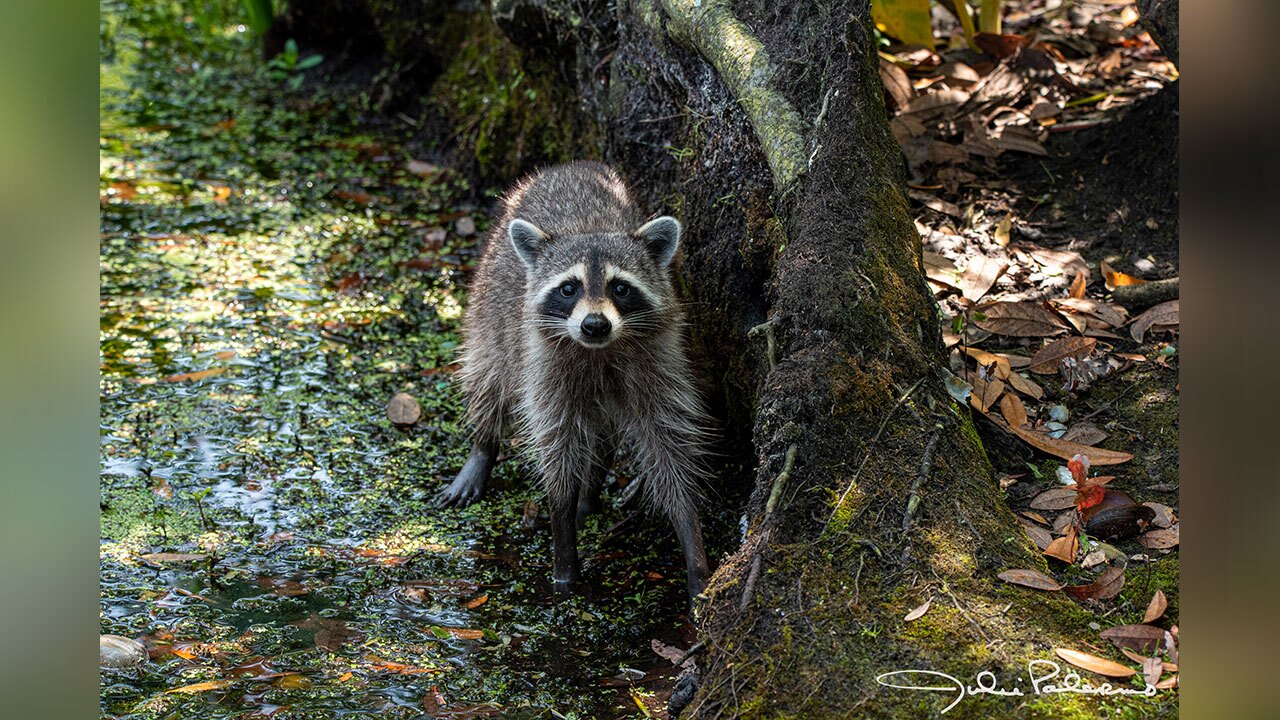
Rebecca says: These stripe-tailed, bear-like arboreal animals are found all over Florida and can survive in almost any habitat. Intelligent and dexterous, they can use their tiny hands and thumbs to open all sorts of containers – so make sure you keep your food safely stored while camping! Raccoons are important native animals, but when people feed them (on purpose or by accident) they can become a nuisance. Although it’s not all that common to actually see a raccoon in the middle of the day.
*Paw prints count as a sighting
Mystery animal #5: Brown anole

Rebecca says: Sadly, like a couple of the other animals on this list, the often-seen brown anole is actually considered invasive in Florida. Native to the Caribbean isles, brown anoles have become one of the most abundant reptiles in our state since their accidental introduction and have caused significant harm to the population of native green anoles, not just by competing with them for food and resources but also by actively attacking and eating them! The two species can be difficult to tell apart - native green anoles can change color to a dull brown, but brown anoles cannot change their color to green.


